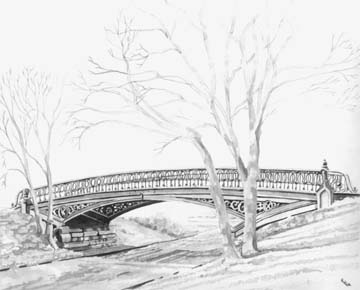Reservoir Bridge Southwest, at the southwest corner of the Reservoir, permits visitors to cross over the bridle path without interfering with the equestrians.
The stone abutments, substantially below ground, support the 38-foot, 2-inch-wide and 10-foot, 9-inch-high arch and a 72-foot span with openwork ornament. The floral scrolls of the cast-iron spandrels and railing reflect an innovative motif of interlacing leaves and curling forms. The posts have tops in the shape of modified urns.
Like the other cast-iron bridges, lack of maintenance and neglect brought about rust, corrosion, and vandalism. In the early 1970s a restoration program, under Director of Historic Parks Joseph Bresnan, combined city and private funds to begin rehabilitation of Central Park's bridges and archways; this bridge was completed in 1979.
Reconstruction of the bridge first necessitated complete removal of all cast iron. Usable railings and ornamentation were salvaged, stripped of encrusted paint, and prepared for reinstallation. The gutter curb and cornice moldings were all numbered for replacement due to the severe deterioration of the original sections. Missing elements were cast from new patterns.
The main structural steel girders were rehabilitated. New structural steel, cambered I-beams, were used to support the new wood decking. After reassembly, the entire structure was painted a rich green, a color selected on the basis of a paint-chip analysis of the old structure. It stands today just as Calvert Vaux first saw it built.
The cast-iron bridges in Central Park are the best surviving collection of cast-iron bridges in America. They are important not only because of the beauty of their design, but because of their role, from the point of view of industrial archeology, in the transition of cast iron to steel.

Elevation with detail of cast-iron railing. Original drawing. 1864.
Municipal Archives.



